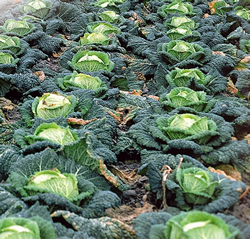
Fewer pesticides could be used and their impact reduced, but to achieve this quickly, consumers and supermarkets need to recognise that their demands for high standards of food appearance must change, argues James Clarke, ADAS' head of sustainable crop management.
Consumers demand increasingly high standards of food quality – food that is safe, free of serious blemishes, available almost continuously and containing the minimum necessary levels of artificial chemicals. To produce blemish-free food and to extend food production throughout the year, farmers and growers have traditionally relied on pesticides. However, retailers and consumers are now demanding increasingly low levels of pesticide residues in the food they eat.
So what are the opportunities and challenges for reducing pesticide use? There is limited evidence on how well matched pesticide use is to the crop protection needs of crops, but where this has been investigated there appear to be considerable opportunities to reduce pesticide use. A significant proportion of pesticides used on fresh produce are used to reduce cosmetic blemishes and if consumers were prepared to accept food with more of these blemishes reductions in use could be achieved quite quickly. Consumers would also need to realise that food from the UK may not be available for such extensive periods and they may also have to pay more. Growers would generally be prepared to reduce use – after all if it does not affect output it will reduce costs - but they have real issues to contend with. These include balancing energy, labour and machinery costs along with dealing with increased incidence of pesticide resistance.
There are several good examples of reduced pesticide use. For instance, increasing use of 'natural' biological control agents and other Integrated Pest Management (IPM) techniques have become the norm in some protected cropping systems. The best example is tomatoes where UK growers are now working towards zero pesticide use through the use of IPM. Its use in other protected crops is increasing and people are now looking to extend this into more widespread use in field crops and production. However, this will be much more difficult where there is less control over the growing environment. Even IPM and biological control are not without consumer problems: many of the 'good' (beneficial) insects used to control the pest species can sometimes be found as contaminants in fresh or processed produce. To a consumer, if it has legs on it they do not want it in the produce they buy – whether it's a good or bad species!
How can we continue to strive to reduce the use of pesticides and therefore reduce the risks of residues on crops as well as ensuring that shelves are stocked with blemish and pest-free produce? Generally this would be a longer-term aim and is less easy to achieve quickly. It requires a combined approach of reducing risks through both IPM and plant breeding (for pest and disease resistance) as well as enabling better decision-making. One route to better decision-making is through an improved ability to monitor and forecast pest and disease pressures and hence with confidence to reduce the need to apply pesticides. In some crops, there are now decision-support systems that are becoming available to help with this – but as yet they are neither widely used nor available for many of the more minor or fresh produce crops. One of the most advanced systems aims to improve disease management in winter wheat, which accounts for over half the pesticide use in UK. In 2004, 150 wheat farmers and agronomists tried the Wheat Disease Manager system and it very accurately helped them to understand how much fungicide they needed to apply and how frequently. For instance it allowed fungicide use to be reduced by up to one third by matching crop protection needs to varietal tolerance. In addition, other systems are in development for managing weeds in winter wheat, for pests and diseases in oilseed rape and for cereal pests. These systems need to take account of weeds, pests and diseases developing resistance to pesticides. In all cases they also provide detailed information on non-pesticide options to reduce pressure from weeds, pests or diseases, including the use of tolerant varieties (where available) and changes to crop management.
One potential issue in relation to improved decision-making is that if fewer pesticides are applied in anticipation of a likely benefit, they may be used later in the growing cycle when a problem has developed further. This might mean higher rates applied closer to harvest. There is a risk in such situations that pesticide residues might be more likely to be detectable at harvest. Better forecasting of development of pest and disease outbreaks is therefore required as well as forecasting of the implications of different control strategies on the likelihood of pesticide residues being present.
Other options for the future might include use of naturally derived bio-pesticides. Many people presume these to be safer for consumers, for users and for the environment. However, the safety and role of such products needs careful evaluation. Other ways of minimising pesticide use include improved crop storage and management, improved field application technology, improved exploitation of varietal resistance and increasing the opportunity for natural predation. These are all areas that need further research.
In conclusion, it is possible to reduce pesticide use but to do so presents several challenges. These are:
• To make reductions quickly, consumers and retailers need to be prepared to accept less 'perfect' looking food and possibly increased prices.
• Longer-term reductions could be achieved, but farmers and growers need to be better equipped to forecast the development of and risk from weeds, pests and diseases.
• There needs to be a greater ability to use Integrated Crop Management in outdoor crops, as well as a wider availability of alternative methods of weed, pest and disease control.
• There needs to be a greater understanding and predictability of the risks associated with later timings of pesticides on detectable residues being found.
